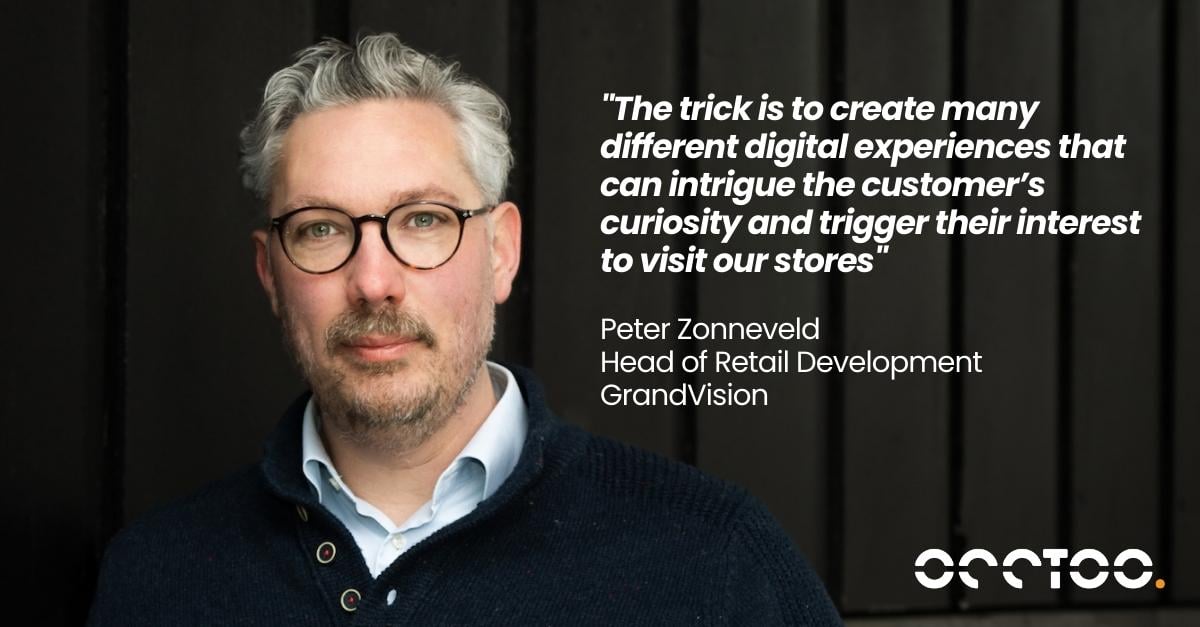We're interviewing some of the most influential people in the digital retail space to bring you some of the hottest insights and learn what's next for the future of customer experience in retail.
This week we spoke with Peter Zonneveld, Head of Retail Development at GrandVision, a global optical retailer and part of EssilorLuxottica. An experienced technologist, Peter has been working in the IT industry for over 17 years solving digital challenges and ideating innovative technology-led business strategies.
Peter’s current role involves him to manage, lead and structure the retail development division at GrandVision. GrandVision is a world leading retailer in eyewear and eyecare with 33 brands in 44 countries and 7000+ stores.
You can view the full collection of our Top Voices in Retail interview series here.

Hi Peter, can you please elaborate a little on your background?
I have spent over 17 years now working in IT, started out as a developer and have been managing teams since 2012. My work experience ranges from developing enterprise software with the latest relevant backend and frontend technologies to leading and delivering software with product owners, developers, sre/devops teams and solution architects.
I was always interested in front-end specialization and back in the early days, I was working for Hallmark and we were one of the front-runners in merging online and offline customer experience, we created an app where customers could create a greeting card design online and then have it delivered to the person they wanted to send the greeting card. That was my very early and initial experience of creating a somewhat omnichannel customer experience.
Throughout my career trajectory, I have been a strong advocate of finding technology-led solutions that speed up processes both for the company and the consumer.
What are your responsibility at GrandVision?
Currently, I am responsible to head the retail development division and have 14 direct reports and about 50 external collaborators. Together, we are responsible for in-store innovations and technology led projects for our 7000+ stores worldwide. I started the digital transformation journey of GrandVision in 2017, my vision was to get all our brands under one platform.
My first three years at GrandVision were more about developing and strengthening our e-commerce solutions whereas my current focus is to find a new point of sale and unify all our digital solutions to one seamless experience.
Who would you say is your typical customer?
A typical customer is someone who is in need of eyecare, so anyone who is experiencing headaches or loss of vision or eyesight related issues can be our customer. Sometimes these kind of customers are unaware that they are in need of optical wear and so we do target them through awareness based marketing and communications campaigns. And then we have also the other set of customers who are already wearing glasses and are aware of their needs and reach out to us as loyal customers or because of our expertise and reputation in the market.
Through the different brands in our portfolio we can provide both high-end eyewear and more affordable eyewear to fit different types of wallets. We reach out to both of these customers through our stores as well as online/digital channels. When it comes to stores, we have to follow an aggressive ‘stay close to your competitor’ strategy meaning that we have stores next to, or very close to, our competitor’s stores just so that the consumer who walks in to their stores, also can walk in to ours and experience the difference in the product assortment and quality.
What have you executed to deliver on your customers digital expectations?
When it comes to creating digital experiences, our first goal is to provide a great seamless customer experience that can push them down the funnel and eventually lead to a sale, be it offline or online. So the trick is to create many different digital experiences that can intrigue the customer’s curiosity and trigger their interest to visit our stores. We also added an online appointment solution which has become a very popular service among customers.
In the past, we have experimented with AR/VR technology as well to create compelling digital experiences and in my opinion, you have to try your hand at a lot of different digital initiatives to really understand what goes as a hit or a miss with your target audience.
On the other hand, we also had initiatives that encouraged personal interaction with our consumers, for instance, we offered live sessions with optometrists that shared really useful information about how people should deal with eyesight issues such as headaches etc. So there is no tried and tested formula when it comes to creating digital experiences, the more experiences you can offer, the better. The more you can interact with your audience, the more are your chances of conversion.
If you were to give one piece of advice for others working with digital experience, what would it be?
I would say that having new innovative ideas is really great but executing them is one thing, and that should be left to professionals. It is like buying a house, you can have a plan and maybe some ideas but leave the rest to the architects. Set something up but don’t over-engineer it whether it is a customer experience, a new app or a tool. Don’t get stuck in the cycle of endless A/B testing, instead focus your attention on shipping new customer-centric digital experiences that allow you to gain insights and act as an opportunity to get closer to your customer.
Learn more:
- Cartier launches new eCommerce feature to help clients filter through their fragrance collection
- Retailer MQ Marqet use digital experimentation and a strong service offering to boost customer experience
- Inspiring ways to digitalize your in-store experience, with examples from Cartier, Axel Arigato and MQ Marqet